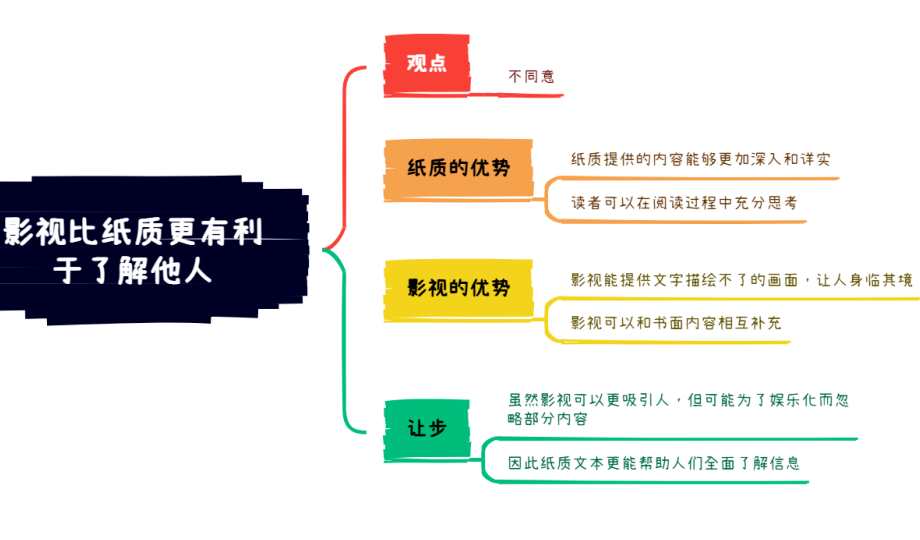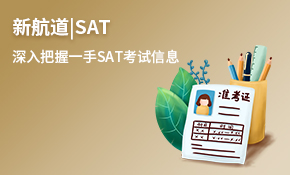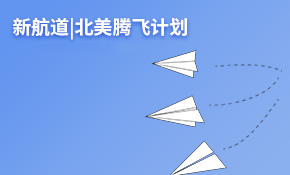2024.9.7雅思写作考题8分范文及解析:影视比纸质更有利于了解他人生活
今天,新航道南京雅思培训学校小编带大家一起来看一下2024.9.7雅思写作考题8分范文及解析:影视比纸质更有利于了解他人生活。
观点类大作文,文化类话题
In order to learn the way other people in the world live, it is better to look at film and video records than written documents. To what extent do you agree or disagree?
题目来源:2024年9月7日雅思大作文
1
题目大意
为了了解世界上其他人的生活方式,最好看电影和视频记录而不是书面文件。你在多大程度上同意或不同意?
2
思路解析
这是一道观点类大作文,聊的是影视资料和书面资料哪个用来了解世界上其他人的生活方式更好。题目理解不难,但实际写一起来有一些难度,需要注意两个点,一是题目限定了讨论前提“In order to learn the way other people in the world live”,也就是说不要单纯讨论影视和纸质材哪个更好,而是要基于“了解世界其他人生活方式”这一目的去讨论。二是题目观点存在比较关系,因此需要对双方优劣势进行论证。下面,王珍老师带大家来看下具体观点。
首先来看同意的角度,有三方面。
一是影视更直观形象。通过影视和视频记录,观众可以直接看到真实的场景和生活方式。这种直观的视觉体验能够传达细节,比如环境、人物表情、服饰等,这些都是书面资料难以呈现的。视频还能通过音效、背景音乐等强化情感表达,帮助观众更好地理解他国人民的生活。
二是影视往往更新速度快,能够反映最 新的社会变化。在互联网的环境下,影视和视频的制作周期短,在社交媒体上发布更为及时,能够迅速反映一个国家或地区的最 新社会动态与生活状况。例如,新闻报道、视频博客等可以实时展示某一国家的日常生活及其最 新变化,而书面资料往往需要较长的时间进行研究和出版。
三是影视更具吸引力,娱乐性和互动性更强,可以通过网络社交平台快速传播,尤其适合那些不习惯长时间阅读书面材料的人群。例如,纪录片、旅游视频和生活记录片通常能获得比书籍更广泛的观众,尤其是在年轻群体中,通过这种形式了解他国文化会更加高效。
再来看反对的角度,有两方面。
一方面书面资料更加深入详尽,与影视和视频相比,书面资料能更加系统地呈现文化和历史的全貌。例如,了解某个国家的社会结构、历史渊源等,书面资料通常经过严谨的研究和详细的论述,能够提供更为深入的背景信息,而影视作品往往限于时间和叙述方式,无法深入探讨。
另一方面,书面资料阅读过程更有助于思考和分析。书面资料要求读者进行主动阅读和深度思考,人们可以在阅读过程中慢慢消化信息,并进行批判性分析,这有助于理解复杂的文化现象。而影视和视频的观看过程较为被动,观众往往只接受影像中的表面信息,而不深入思考其背后的含义。
3
提纲

4
高分范文示例
In an increasingly globalized world, people seek diverse ways to understand the lives of others across different cultures. Some argue that films and video records are more effective than written documents in achieving this goal. I disagree with the notion that one medium is universally superior to the other, as each serves distinct purposes in providing cultural insights.
To begin with, written documents offer depth and context that are often lacking in films and videos. Historical texts, scholarly works, and literature can provide in-depth explanations of cultural customs, historical events, and societal structures. For example, reading about Japan’s feudal era through academic papers offers comprehensive insights into the political and social systems that cannot be fully conveyed in a short documentary. Written documents also allow for careful reflection and analysis, as readers can pause and revisit complex ideas, enabling a more thorough understanding of nuanced cultural practices. Thus, written records remain invaluable for those who seek a detailed and analytical grasp of a culture.
On the other hand, films and videos excel in portraying the emotional and visual aspects of daily life, which can be difficult to capture in writing. Visual media offer a more immersive experience, allowing viewers to observe body language, facial expressions, and environmental contexts that are integral to understanding how people live. For instance, a documentary on the bustling streets of Mumbai can vividly convey the chaos, energy, and human interactions in a way that text alone may struggle to achieve. Therefore, films and videos offer an immediacy and emotional resonance that complement written descriptions.
While it is true that films and videos can offer a more engaging way for people to learn about different cultures, they often oversimplify or sensationalize aspects of daily life for entertainment value. Documentaries, for example, may focus on dramatic or picturesque moments while ignoring the more mundane but equally important aspects of a culture. In contrast, written documents can provide a more balanced and comprehensive account, ensuring that readers understand not only the highlights but also the subtleties of a given society. Consequently, despite the appeal of films and videos, written texts continue to play a crucial role in delivering a well-rounded understanding of cultural diversity.
In conclusion, while films and videos offer a compelling and visually rich way to learn about how others live, written documents provide the necessary depth and context to achieve a fuller understanding. Each medium has its strengths, and together, they complement each other in enhancing cross-cultural knowledge.
5
相关词汇和语法结构
Globalized world 全球化的世界
Cultural insights 文化见解
Unique benefits 独特的好处
In-depth explanations 深入的解释
Scholarly works 学术著作
Cultural customs 文化习俗
Historical events 历史事件
Societal structures 社会结构
Comprehensive insights 全面的见解
Nuanced cultural practices 微妙的文化习惯
Audiovisual experience 视听体验
Emotional resonance 情感共鸣
Immersive experience 沉浸式体验
Body language 肢体语言
Facial expressions 面部表情
Human interactions 人际互动
Language barriers 语言障碍
Dramatic moments 戏剧性的时刻
Mundane aspects 平凡的方面
Balanced and comprehensive account 平衡且全面的描述
来源:雅思情报圈
以上就是新航道南京雅思培训学校小编分享的2024.9.7雅思写作考题8分范文及解析:影视比纸质更有利于了解他人生活的全部内容 ,大家可以参考一下,更多有关雅思备考的问题,可以咨询新航道雅思老师哦~
















